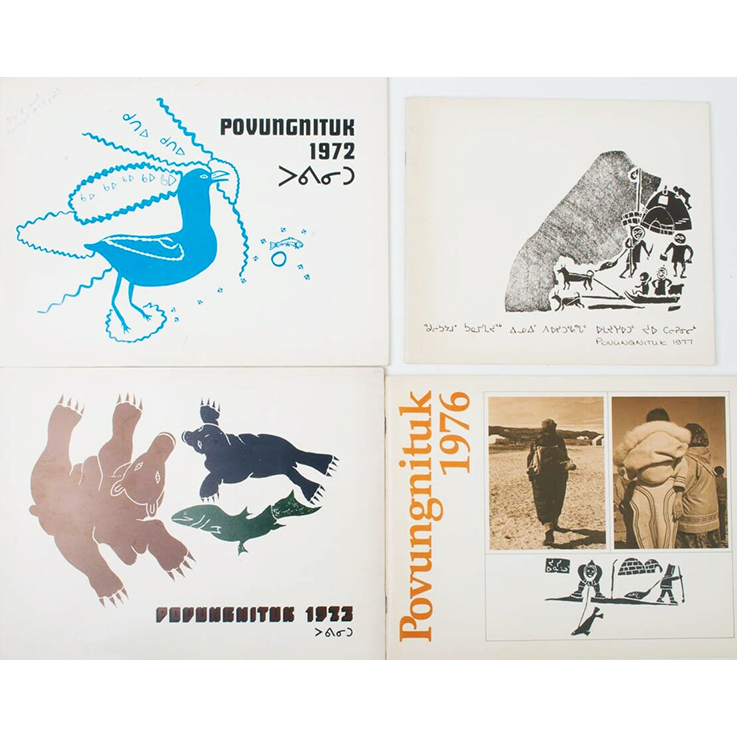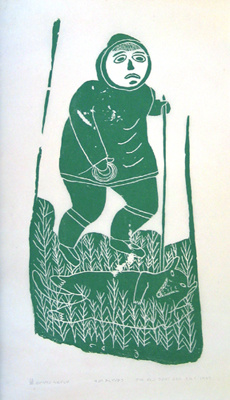Leah Qumaluk: Povungnituk
Leah Qumaluk (1934-2010) - Artist Biography
Born in 1934 to Raina Nuluki from the Belcher Islands and Samisa Sala from Kuujjuarapik, Leah Qumaluk settled in Puvirnituq with her husband, Josie Qumaluk, in the mid 1950s.
Actively involved with the Puvirnituq print shop since its inception, Qumaluk worked as both a printer and an artist from the early 1960s. Her work was first publicly recognized in 1962, when one of her prints was featured in the first release of the annual Povungnituk print collection.
Qumaluk married into a famous family of carvers when she wed Josie Qumaluk as a young woman. Daughter-in-law to the well-known sculptor Tania the Elder and sister-in-law to Eli, Umajualu, Levi, and Eisapi Qumaluk, Leah was undoubtedly inspired by the steady production of artwork that surrounded her.
Although best known for her expressive works on paper, Qumaluk also produced a handful of carvings. While the bulk of her oeuvre consists of stonecut prints, she also experimented in batik in the early 1970s and with stencil work in the late 1970s to the early 1980s.
A pioneer in the field of printmaking in Puvirnituq, Qumaluk was one of the few people involved with the print shop from its inception in 1962, staying almost until its closure in 1989. As both printer and artist Qumaluk had, wrote Janet Berlo (1989: 307), the unique distinction of being “an artist who often controls all aspects of her own graphics, from initial idea to final printing; this puts her in an unusual category, shared by only a handful of other artists.”
A prolific artist and mentor in the Puvirnituq print shop, Qumaluk’s prints were included in 17 of the 20 annual print releases from that community. Her work has been featured in countless publications and has been exhibited in New York, Paris, and Belgium. It is held in private collections worldwide and in important national collections, such as those at the National Gallery of Canada, the Canadian Museum of Civilization, and the Winnipeg Art Gallery.
Among the first artists to attempt printmaking in her community, Qumaluk’s early work is surprisingly assured. The artist immediately began to tackle complex scenes that were highly charged and repeatedly featured violent imagery. Dogs are strangled; meat is vigorously sliced; bears attack with elongated claws and pointed tongues; animals and humans morph into otherworldly creatures. Her early work is, however, also peppered with less ominous scenes that quaintly depict the tasks of everyday life, images that would dominate much of her later work. By the 1980s, Qumaluk’s focus had shifted almost exclusively to domestic scenes and wildlife imagery, and her participation in the print shop as a printer far outweighed her output of original imagery. She resigned from the print shop in 1985, shortly after the death of her husband. Her work continues to be exhibited on a national level, and was most recently featured in Women of the Arctic at La Centrale Galerie Powerhouse in Montreal in December 2010.
Public Collections:
Agnes Etherington Art Centre, Queen's University, Kingston
Art Gallery of Greater Victoria, Victoria
Avataq Cultural Institute, Montreal
Bata Shoe Museum Foundation, Don Mills
Canadian Museum of Civilization, Gatineau
Confederation Centre of the Arts, Charlottetown
Confederation des caisses populaires et d'economie Desjardins, Levis
Dennos Museum Center, Northwestern Michigan College, Traverse City
McMaster University Art Gallery, Hamilton
McMichael Canadian Art Collection, Kleinburg
Musee d'Art Contemporain de Montreal, Montreal
Musee de la civilisation, Quebec City
Musee des beaux-arts de Montreal, Montreal
Musee du Quebec, Quebec City
Museum of Anthropology, University of British Columbia, Vancouver
National Gallery of Canada, Ottawa
University of Lethbridge Art Gallery, Lethbridge
University of New Brunswick, Fredericton
Winnipeg Art Gallery, Winnipeg
Artist Specialization: Drawing mainly on a large repertoire of Inuit myths and legends, Qumaluk tended to focus on the portrayal of various elements from these well known stories. Unusual, mischievous spirits such as the larger-than-life bird figure, Tatigak, are often featured in her pieces and are balanced by more staid images of commonplace activities, such as hunting and scenes of camp life.




